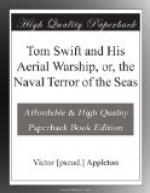“I have first to determine where I want to drop the bomb,” Tom explained, “and then I have to get my distance from it on the range-finder. Next I have to know how fast I am traveling, and how far up in the air I am, to tell what the velocity of the falling bomb will attain at a certain time. This I can do by means of these instruments, some of which I have adapted from those used by the government,” he said, with a nod to the officer.
“That’s right—take all the information you can get,” was the smiling response.
“We will now assume that the bombs are in place in the holes in the floor of the cabin,” Tom went on. “As I sit here I have before me three buttons. They control the magnets that hold the bombs in place. If I press one of the buttons it breaks the electrical current, the magnet no longer has any attraction, and it releases the explosive. Now look down. I am going to try and drop a chalk bomb near that stone fence.”
The Mars was then flying over a large field and a stone fence was in plain view.
“Here she goes!” cried Tom, as he made some rapid calculations from his gauge instruments. There was a little click and the chalk bomb dropped. There was a plate glass floor in part of the cabin, and through this the progress of the pasteboard bomb could be observed.
“She’ll never go anywhere near the fence!” declared Ned. “You let it drop too soon, Tom!”
“Did I? You just watch. I had to allow for the momentum that would be given the bomb by the forward motion of the balloon.”
Hardly had Tom spoken than a puff of white was seen on the very top of the fence.
“There it goes?” cried the lieutenant. “You did the trick, Swift!”
“Yes, I thought I would. Well, that shows my gauges are correct, anyhow. Now we’ll try the other two bombs.”
In succession they were released from the bottom of the cabin, at other designated objects. The second one was near a tree. It struck within five feet, which was considered good.
“And I’ll let the last one down near that scarecrow in the field,” said Tom, pointing to a ragged figure in the middle of a patch of corn.
Down went the cardboard bomb, and so good was the aim of the young inventor that the white dust arose in a cloud directly back of the scarecrow.
And then a queer thing happened. For the figure seemed to come to life, and Ned, who was watching through a telescope, saw a very much excited farmer looking up with an expression of the greatest wonder on his face. He saw the balloon over his head, and shook his fist at it, evidently thinking he had had a narrow escape. But the pasteboard bomb was so light that, had it hit him, he would not have been injured, though he might have been well dusted.
“Why, that was a man! Bless my pocketbook!” cried Mr. Damon.
“I guess it was,” agreed Tom. “I took it for a scarecrow.”




